
 |
Flashing on Australian commerial clay bodiesSidestoke home | Firing the tests | Oztrain kiln | Rosser reduced cooling |
| Red/orange
flashing and reduced
cooling
by Carol and Arthur Rosser Flashing is just one of the infinite number of effects which can result from long wood firings but clay bodies often do not cooperate and desirable colours can be elusive. It is common practice to apply slips and shino-type glazes to obtain similar colours but that is one more thing to do, and anyway there is something very satisfying and direct about firing the unadorned clay. For a long time we have been encouraging flashing on clay bodies based on mixtures of a local iron bearing clay and white firing stoneware bodies. To ensure the development of red/orange flashing we use a particular cooling procedure and if we deviate from this the results are unsatisfactory. The white firing bodies were either commercially available bodies or bodies we have mixed ourselves from commercial milled ingredients |
|
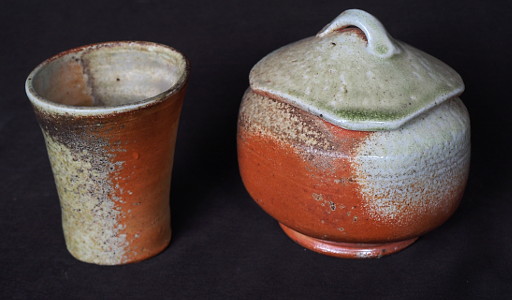 |
|
| Flashing on pots
made from bodies not available commercially |
|
| The Skardon River clay body used for
the lidded jar in the photo has this composition: Skardon River clay body Skardon River kaolin 33 Crediton clay 27 Soda felspar 23 Silica 13 The Crediton clay is dug about 15km from home and has about 2.4% iron oxide. Skardon River kaolin deposit is located near Weipa, Queensland Reason for testing commercial clay bodies In order to ennable helpers to make pots of their own to bring to firings we have felt the need to find clay bodies which do not involve Crediton clay and which will produce warm flashing colours under the same firing regime. So we have run a series of tests of commercially available clay bodies, and mixtures of these bodies, and some of the results are shown below. |
|
| Types
of wood used The main wood used in all our
firings has been Blackwood (Acacia
melanoxylon), with a variety of eucalyptus woods used in
the early stages only. Flashing does not happen when the natural
ash glaze is thick, so this is a major concern when packing the
pots. It is possible to get huge quantities of natural ash glaze
with Blackwood so the duration of stoking with it must be
considered carefully. Obviously the quality of the flashing
will depend on the wood used and in this respect it may be that
Acacias are more useful than Eucalypts as sources of wood.
We would really like to know what happens using wood from other
species but Blackwood is what is readily available in our area and
we have become familiar with the variety of ash effects it
produces so that is what we use. Blackwood's prodigious production
of ash glaze seems to cause crawling on shino glazes if used too
early in the firings so we use eucalyptus wood until the
temperature at the front of the kiln has reached 1,000
degrees C.
The kiln The tests were
fired in our Oztrain
kiln.Firing
Our firings are usually 40 hour reduction firings to cone
10 or higher, and we use the Rosser
reduced cooling
procedure in the early stages of cooling. This involves some
cooling under reduction followed by a period of oxidation,
and is dealt with at length here.
A
short description of the cooling of the firing of the test
mixtures is given here. We use an
oxygen probe to make sure we are maintaining the right atmsopheric
conditions during the critical periods during cooling. As usual
the main wood used was Blackwood, with Flooded Gum (Eucalyptus
grandis) used in the early stages. Although we
usually use green ginger leaves as a reducing agent during cooling
this was not necessary on this occasion because the ember bed was
so big that reduction occurred naturally in the 1,000 to 900 deg
range.
|
|
|
The
clay
bodies
A few tests involved a clay body which has this composition: Rosser body Crediton clay 80 potash felspar 8 silica 12 The iron oxide content of this clay body is 1.9% With the exception of Clayworks TMK and Kagero the commercial clay bodies were as available in early 2014. The Kagero used was a few years older and the TMK sample was much older, possibly a decade older. There is no guarantee that the clays of the same names being sold now have the same composition as the ones used in the tests. Tests of TMK bought in 2016 were much less promising, indicating that the TMK body has indeed changed over the years. We once had an unfortunate anagama load involving a mixture of Rosser clay and a new batch of Feeney's white stoneware clay. To our disgust this brew did not produce orange/red flashing at all. Public flogging should be reinstated as a punishment for clay manufacturers who change the composition of their clay bodies without informing customers. |
| Test results The photographs were taken in full sunlight and the saturation setting on the Olympus OMD EM5 camera was "Natural". The colour rendition on your screen will depend on your particular device. The clays were mixed dry then mixed with water and dried out to plastic state and formed into test tiles. When mixing larger quantities of clay bodies in plastic state it is sufficient to knead the mixtures thoroughly or put them through a pugmill. |
||
|
Interpret the numbers like this: The tile at near right consists of 2 parts Clayworks TMK mixed with 1 part Rosser clay |
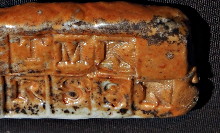 |
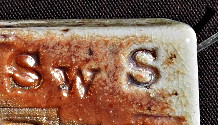 |
| 2
Clayworks TMK + 1 Rosser |
2
Clayworks SWS + 1 Rosser |
|
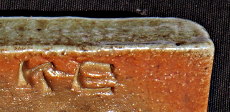 |
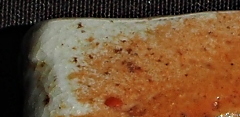 |
|
|
Keane
Flash
|
2 TMK +
1 Keane Flash
|
|
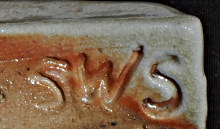 |
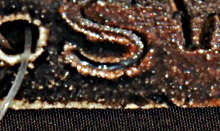 |
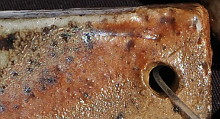 |
| SWS | Clayworks
SW |
1 SWS + 1 SW |
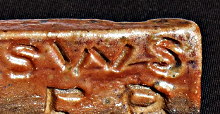 |
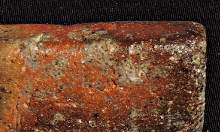 |
|
| 1 SWS + 1 Keane 5B |
2 SWS + 1 Clayworks Kagero | |
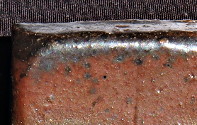
|
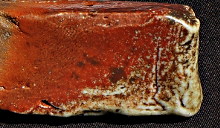 |
|
| Clayworks RGH | 2
TMK + 1 RGH |
|
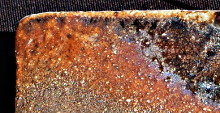
|
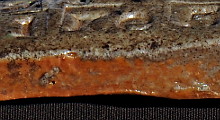 |
|
| Keane 5B | 2 TMK + 1 Keane 5B | |
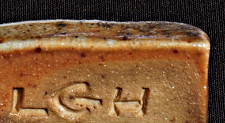
|
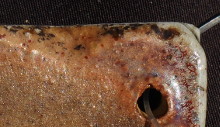 |
|
| Clayworks LGH |
Clayworks CWR |
|
| Sidestoke home | Firing the tests | Oztrain kiln | Rosser reduced cooling |